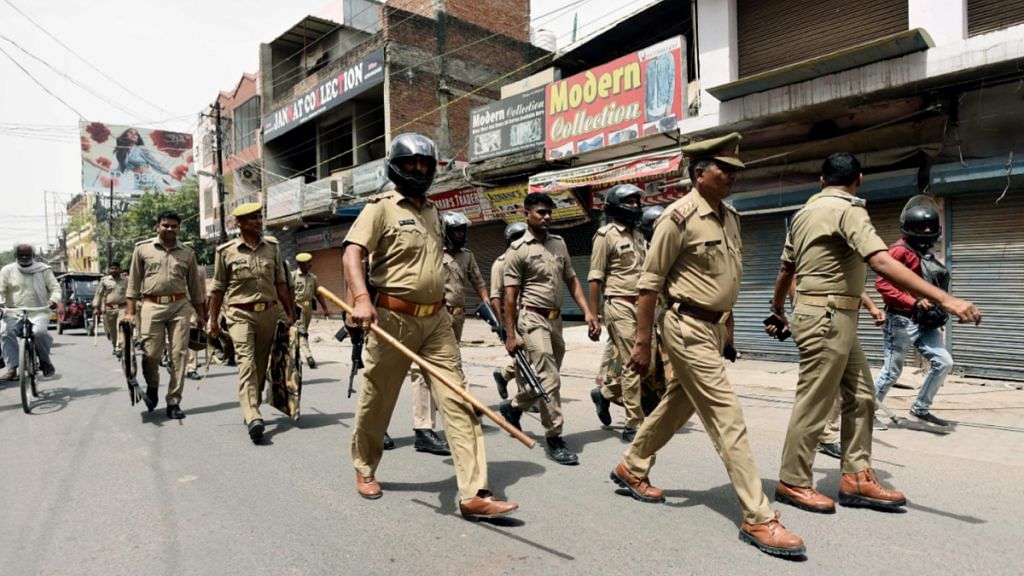If Narendra Modi’s first term in office abounded with brazen institutional subversion, his second has been beleaguered by spirited citizenly uprisings. In the weeks leading to the coronavirus pandemic, lest we forget, the prime minister was besieged by a wave of challenges. Protests against the Citizenship Amendment Act, erupting months after the BJP’s triumphant re-election in 2019, had spread to every major city by early 2020. Modi, having grown accustomed to spectacles of submission by the public, was rattled by this show of defiance. His government invoked a colonial-era law to ban gatherings of more than four people, intermittently suspended the internet, and mobilised its base by amplifying sectarian messaging. As police truncheons bloodied young protestors in Delhi, Modi lashed out at rootless cosmopolitans and Muslim troublemakers, supposedly identifiable by their clothing.
The script did not yield the intended result. Across the country, Indians of all faiths joined to proclaim their allegiance to secularism—the foundational basis of the republic. Their song was the national anthem, their standard the Indian flag, and their holy book the Indian Constitution. In Delhi, Hindus formed a human chain to protect Muslim worshippers. In Hyderabad, tens of thousands of Muslims recited the preamble to the Indian Constitution: “We, the people of India, having solemnly resolved to constitute India into a sovereign socialist secular democratic republic…”
The pandemic granted Modi a reprieve, but did not extinguish the indignation incubated by his attempts to remake India in accordance with his ideology. If anything it clarified the supreme contradiction of the “New India”: the prime minister has a dominant majority in Parliament and appears invincible at the polls—and yet his reign has provoked the most persistent dissent on the street in memory. The harrowing experience of the lockdowns should not eclipse the fact that 2020 was a year also of the most sustained democratic uproar against a government anywhere in the world. Measured by numbers, the demonstrations against the BJP’s labour laws and farm laws—drawing hundreds of millions of people—were the largest in human history. Laws were railroaded and rubber-stamped through Parliament, which has given up even the pretence of deliberation, but their promulgation was overwhelmed by public backlash.
Also read: Dear Congresspersons of conscience, if you don’t remove Gandhi obstacle, you’re helping Modi
Shift of Indian democracy
Indian democracy began as a top-down experiment. It originated in the minds of our founding personalities who raised and nurtured the institutions for its exercise. When the American author Norman Cousins asked Jawaharlal Nehru to outline his legacy, he answered: “Hopefully, four hundred million people capable of governing themselves.” The protests of the past three years reveal the depth to which the inclusive nationalism propagated by the architects of our republic has percolated in the past seven decades. For every Indian violently asserting his or her communal identity, a substantially greater number of Indians are (for the most part) peacefully affirming their citizenly identity.
Indian democracy today is effectively a bottom-up phenomenon: it is ordinary Indians who are performing the role of formal opposition to the government. And if India is the site of democracy’s institutional decay, it is also the setting for its civic reclamation. This is no cause for comfort or congratulation, however, because a million spontaneous mutinies, no matter how exalted their motivation, can only culminate in anarchy if their rage is not absorbed into an organised movement. And what is missing in India is a democratic outfit capable of sublimating the dispersed fury of Indians into disciplined political agitation.
What remains of the official opposition could learn from the Right. The electoral breakthrough of the Bharatiya Janata Party (BJP) was deferred through the 1980s by smaller regional parties and the not unimportant fact that the BJP’s malign image, personified by L.K. Advani, ensured that most factions remained allergic to an alliance led by it. So Advani, because he placed a greater value on his ideology than his personal ambition, handed his party’s leadership to Atal Bihari Vajpayee in 1995.
Contrast this to today. The leadership of Congress, India’s only other credible pan-national party, refuses to relinquish control despite the majoritarian threat to the country. The one event that prompted Congress—an indolent spectator to the people’s protests that jolted Modi—to mobilise its troops was the summons issued to Rahul Gandhi by the Enforcement Directorate in the National Herald case. Crowds were bussed in to the capital and every MP and party official was instructed by the “high command” to materialise in Delhi and march behind the prince. It is difficult to imagine a more egregious insult to the patriotic multitudes exposing themselves to physical harm to foil the government’s excesses than the squalid pantomime organised by the Gandhi dynasty and its lickspittles.
The lesson of India is this: Democracies can survive authoritarians; they cannot survive the absence of an energetic opposition. It is perhaps too late for the Congress to marshal a movement capable of defeating Modi in 2024. But there is time enough for it to retool itself sufficiently to restrict the BJP’s margin of victory. The ordinary people of India are gallantly performing their citizenly duty. They are being thwarted by one family and its minions.
Kapil Komireddi is the author of Malevolent Republic: A Short History of the New India. He tweets @kapskom. Views are personal.
(Edited by Prashant)
